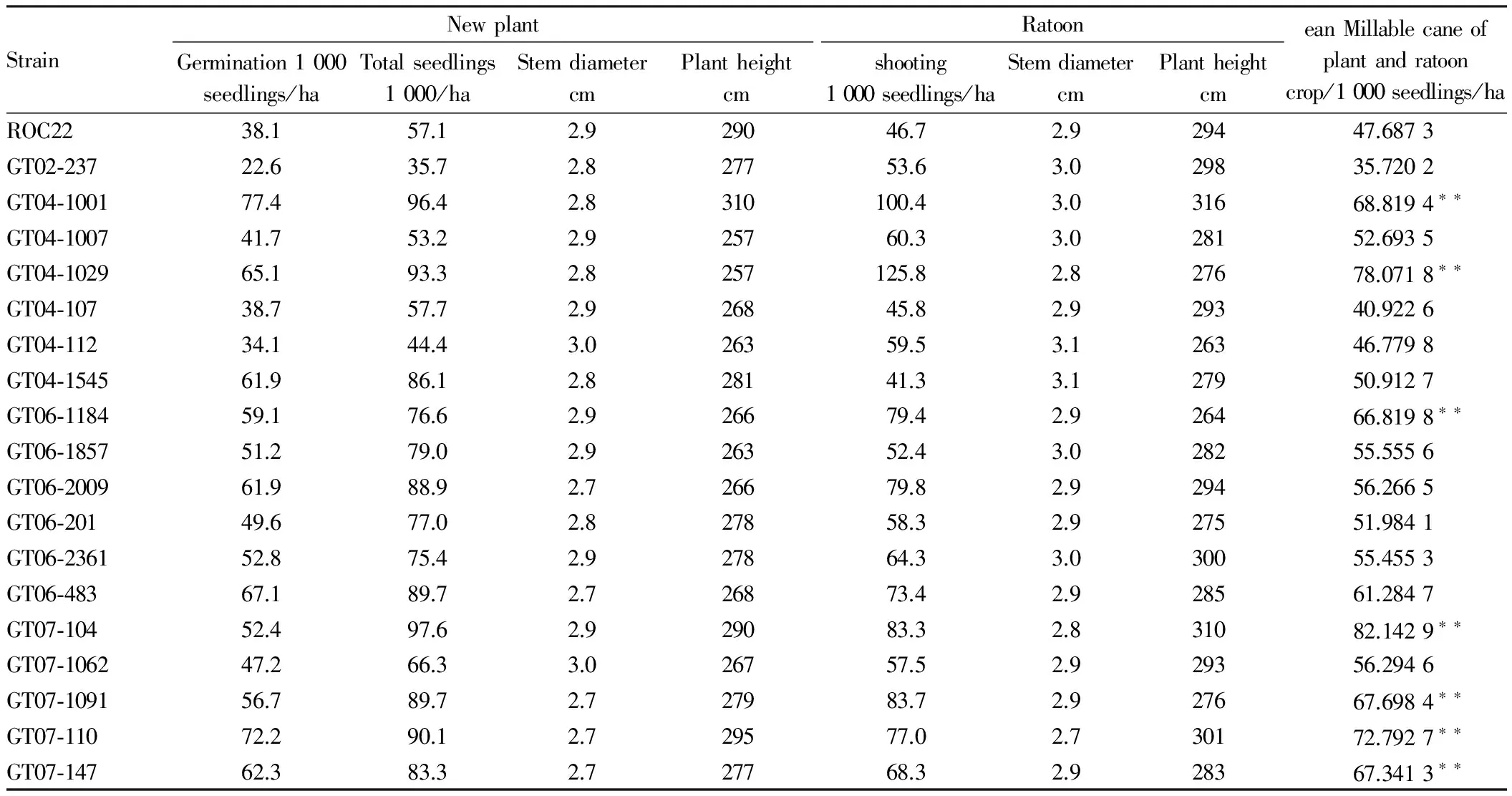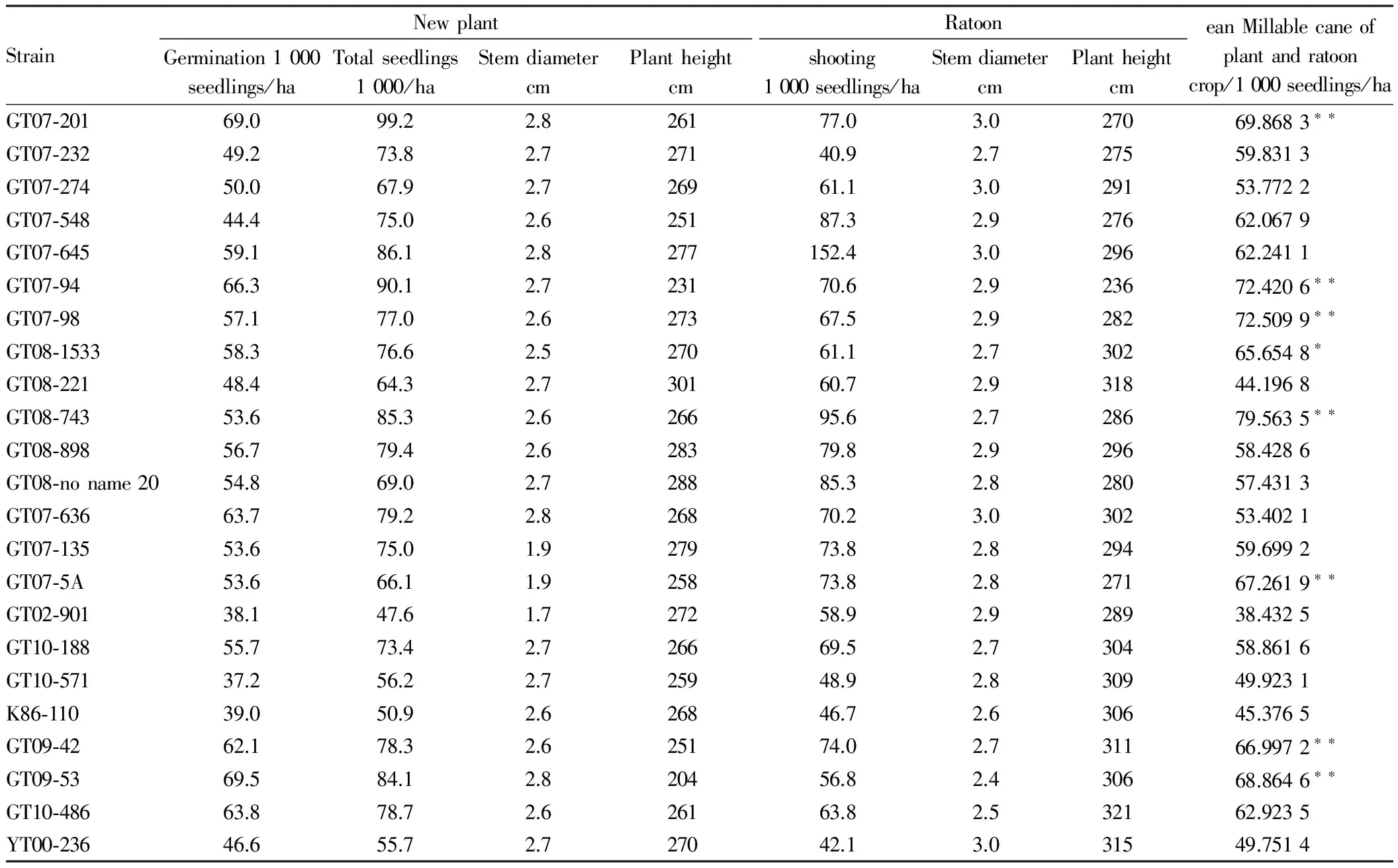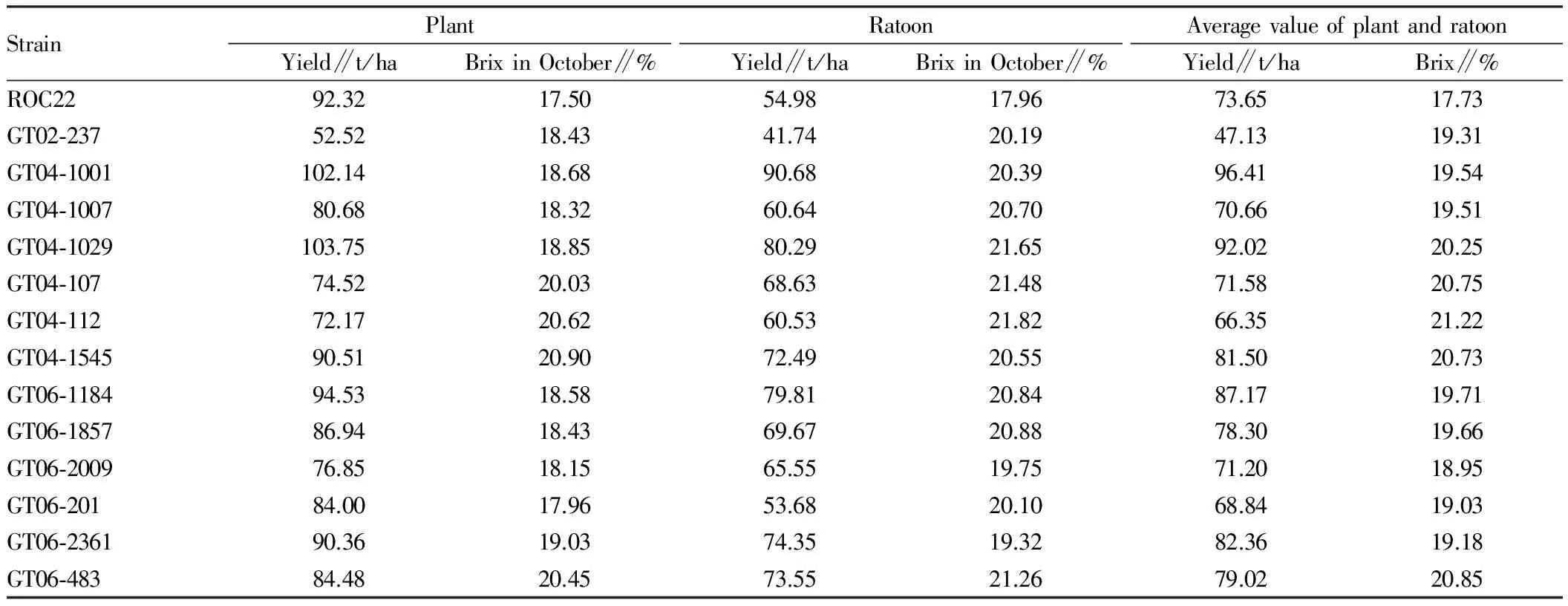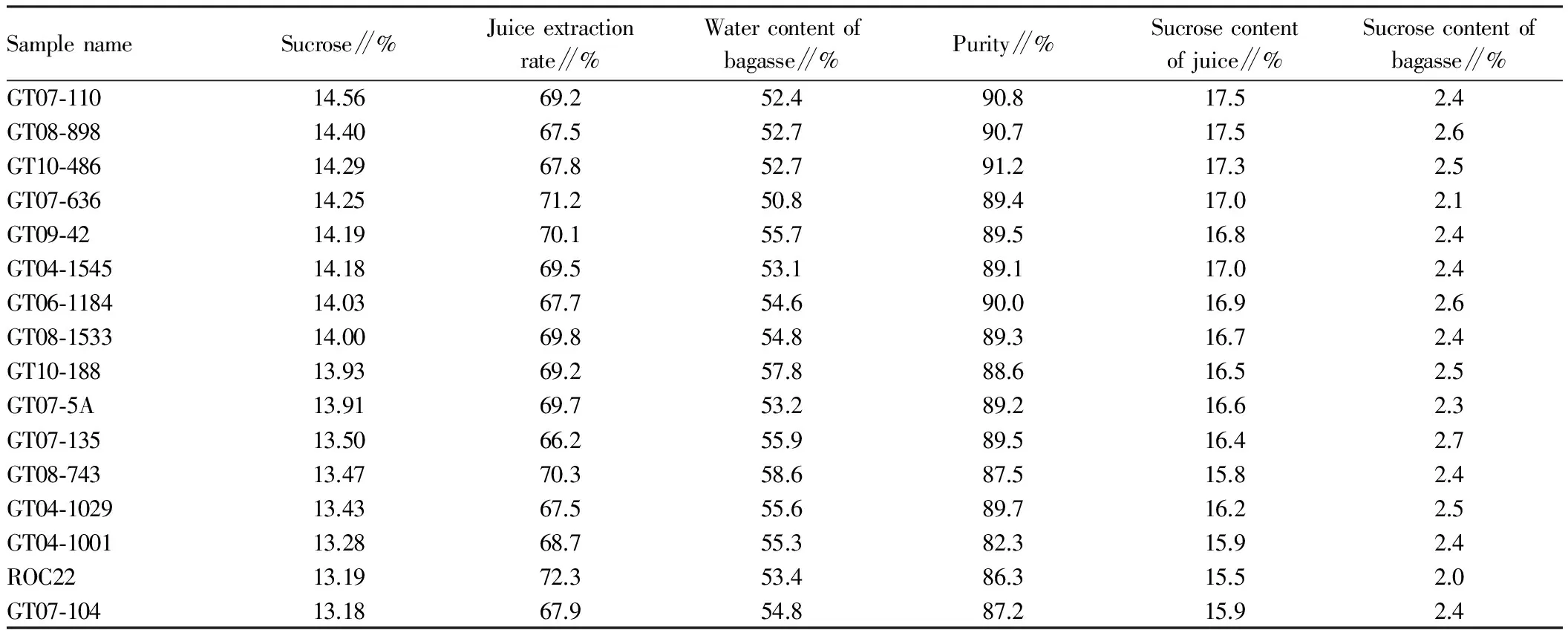Comprehensive Evaluation of Main Traits of Sugarcane Germplasm Resources with High Sucrose Content
2018-03-21,,,,,,,,,
, , , , , , , , ,
Sugarcane Research Institute, Guangxi Academy of Agricultural Sciences; Key Laboratory of Sugarcane Biotechnology and Genetic Improvement (Guangxi), Ministry of Agriculture; Guangxi Key Laboratory of Sugarcane Genetic Improvement, Nanning 530007, China
1 Introduction
In the sugarcane production, sugarcane cane yield and sugar yield are the most important trait indicators. Increasing the sucrose content can bring high economic benefits and will have a great impact on the development of the sugar industry. However, in sugarcane production of most countries, the rate of increasing the sucrose content is not rapid[1]. The sucrose content of sugarcane has a higher heritability than sugarcane production, is more stable and more easily reflected in the process of sugarcane breeding[2]. At present, the main cultivar ROC22 contains low sucrose and the average content of sucrose is 14.0%[3]. In 2009-2010 crushing season, the average sucrose content of sugarcane in Guangxi was 14.0%[4]. This indicates that Guangxi has a high potential for increasing the sucrose content of sugarcane. High sucrose content and adaptability to a variety of ecological conditions are the embodiment of excellent sugarcane varieties. In the intermediate samples and germplasm resources for sugarcane breeding, collecting genetic resources of high sucrose varieties (strains) can provide rich parental resources for excellent high sucrose sugarcane varietiesd[5-8].
Sugarcane Research Institute of Guangxi Academy of Agricultural Sciences has bred many excellent new sugarcane varieties. In the 1980s and 1990s, Guitang 11 (average sucrose content 13.5%) accounted for more than 60% of the cultivated area in Guangxi. In recent years, the average sucrose content of high sugar samples such as Guitang 30, Guitang 29 and Guitang 35 is as high as 16.9%[9]. Some 2007, 2008, 2009, 2010 and 2011 high sucrose varieties in selection nursery showed higher sucrose content than that of ROC22. At present, Hainan Sugarcane Hybrid Base of Sugarcane Research Center of Chinese Academy of Agricultural Sciences provided 775 sugarcane parental samples, and the resource bank conserved more than 900 kinds of germplasm samples. In the newly bred sugarcane intermediate samples, some commercial traits are close to the control variety ROC22, but they fail to be selected and get discarded due to the environmental impact or noncompliance of some traits in the breeding process. These samples can provide high-sucrose or some specific genetic samples and thus are genetic resources with high utilization value. Therefore, collecting excellent high sucrose samples and analyzing their diversity are helpful for improving the evaluation and utilization of these high sucrose sugarcane varieties (strains), and providing references for introduction of sugarcane parents and construction of core germplasm bank.
2 Samples and methods
2.1ExperimentmethodsOne-year plant and ratoon were planted in the field experiment during January 2014 and December 2015.
2.2SugarcanesamplesThe sugarcane samples were provided by Sugarcane Research Institute of Guangxi Academy of Agricultural Sciences. The experimental strains were selected from 2004, 2006, 2007, 2008, 2009 and 2010 conventional breeding intermediate samples and 41 sugarcane samples in Hainan breeding base of Sugarcane Research Institute, and the control group adopted ROC22.
2.3ExperimentdesignThe experiment adopted a random block arrangement of field design, with three repetitions, a row area, row spacing of 1.2 m, and the row length of 7 m. The field management was consistent.
2.4DatacollectionandanalysisSurvey methods: according to trait indicators at the growth stage of sugarcane, the survey was carried out on the germination, total seedlings, and ratoon sprounting at the growth stage; the survey included effective stems, plant height, stem diameter, and Brix at late growth stage. For each repetition, 15 plants were surveyed and records were made. Data analysis: the data collected were sorted with the aid of computer and analyzed with the aid of Excel and DPS.
3 Results and analyses
3.1ComprehensiveperformanceofmainagronomictraitsofsugarcanewithhighsucrosecontentAccording to the results in Table 1, the total seedlings of plant cane GT04-1001, GT04-1029, GT07-104, GT07-201, GT07-110 and GT07-94 were more than 90 000 seedlings per ha; except GT07-135, GT07-5A and GT02-901 having stem diameter less than 2.0 cm, other sugarcane samples had stem diameter about equivalent to that of the control ROC22, there was no significant difference; in terms of the plant height, GT04-1001, GT07-110, and GT08-221 were higher than that of the control group. Besides, ratoon samples GT04-1001, GT04-1029 and GT07-645 had the best performance, only four samples had sprouting lower than the control group; the stem diameter was basically equivalent to that of the control group, without significant difference; 14 samples had plant height greater than 300 cm, and all were higher than the control group ROC22.
In terms of the performance of average millable cane of plant and ratoon crop, taking ROC22 as the control group, the average millable cane of 35 samples were higher than that of the control group, 6 samples had fewer millable cane, including GT04-112, K86-110, GT08-221, GT04-107, GT02 -901 and GT02-237. We used Dunnett control method to analyze the differences in the average effective stems of newly-planted ratoon of the samples. The results showed that: the millable cane No. of 35 samples including GT07-104, GT08-743 and GT04-1029 were higher than that of ROC22, and the differences reached extreme significance with GT07-104, GT08-743, GT04-1029, GT07-110, GT07-98, GT07-94, GT07-201, GT04-1001, GT07-1091, GT07-147, GT07-5A, GT09-42 and GT06-1184. The difference between GT08-1533 and GT08-1533 was significant, and the average stems of newly-planted ratoon were significantly different, indicating that these high sucrose samples had excellent germination rate or sprouting rate, namely, excellent sprouting ability.
Table1Comprehensiveperformanceofmainagronomictraitsofsugarcanewithhighsucrosecontent

StrainNewplantGermination1000seedlings/haTotalseedlings1000/haStemdiametercmPlantheightcmRatoonshooting1000seedlings/haStemdiametercmPlantheightcmeanMillablecaneofplantandratooncrop/1000seedlings/haROC2238.157.12.929046.72.929447.6873GT02⁃23722.635.72.827753.63.029835.7202GT04⁃100177.496.42.8310100.43.031668.8194∗∗GT04⁃100741.753.22.925760.33.028152.6935GT04⁃102965.193.32.8257125.82.827678.0718∗∗GT04⁃10738.757.72.926845.82.929340.9226GT04⁃11234.144.43.026359.53.126346.7798GT04⁃154561.986.12.828141.33.127950.9127GT06⁃118459.176.62.926679.42.926466.8198∗∗GT06⁃185751.279.02.926352.43.028255.5556GT06⁃200961.988.92.726679.82.929456.2665GT06⁃20149.677.02.827858.32.927551.9841GT06⁃236152.875.42.927864.33.030055.4553GT06⁃48367.189.72.726873.42.928561.2847GT07⁃10452.497.62.929083.32.831082.1429∗∗GT07⁃106247.266.33.026757.52.929356.2946GT07⁃109156.789.72.727983.72.927667.6984∗∗GT07⁃11072.290.12.729577.02.730172.7927∗∗GT07⁃14762.383.32.727768.32.928367.3413∗∗
(To be continued)
(Continued)

StrainNewplantGermination1000seedlings/haTotalseedlings1000/haStemdiametercmPlantheightcmRatoonshooting1000seedlings/haStemdiametercmPlantheightcmeanMillablecaneofplantandratooncrop/1000seedlings/haGT07⁃20169.099.22.826177.03.027069.8683∗∗GT07⁃23249.273.82.727140.92.727559.8313GT07⁃27450.067.92.726961.13.029153.7722GT07⁃54844.475.02.625187.32.927662.0679GT07⁃64559.186.12.8277152.43.029662.2411GT07⁃9466.390.12.723170.62.923672.4206∗∗GT07⁃9857.177.02.627367.52.928272.5099∗∗GT08⁃153358.376.62.527061.12.730265.6548∗GT08⁃22148.464.32.730160.72.931844.1968GT08⁃74353.685.32.626695.62.728679.5635∗∗GT08⁃89856.779.42.628379.82.929658.4286GT08⁃noname2054.869.02.728885.32.828057.4313GT07⁃63663.779.22.826870.23.030253.4021GT07⁃13553.675.01.927973.82.829459.6992GT07⁃5A53.666.11.925873.82.827167.2619∗∗GT02⁃90138.147.61.727258.92.928938.4325GT10⁃18855.773.42.726669.52.730458.8616GT10⁃57137.256.22.725948.92.830949.9231K86⁃11039.050.92.626846.72.630645.3765GT09⁃4262.178.32.625174.02.731166.9972∗∗GT09⁃5369.584.12.820456.82.430668.8646∗∗GT10⁃48663.878.72.626163.82.532162.9235YT00⁃23646.655.72.727042.13.031549.7514
Note: Effective stems:*denotes 0.01≤P<0.05, and**denotesP<0.0, the same as below.
3.2PerformanceofsucrosecontentandyieldofsugarcanewithhighsucrosecontentFrom Table 2, in terms of the Brix of newly planted samples in October, except GT07-104, GT07-98 and GT07-548, all other samples had the Brix higher than that of the control group ROC22 (17.5%), and 14 samples had the Brix higher than the control group for more than 14.5%; 41 samples had the Brix in October higher than that of the control group ROC22, and 14 samples had the Brix higher than that of the control group for more than 17.1%, and the average Brix of newly-planted ratoon in October was 17.3% higher than that of the control group ROC22, indicating that the selected 41 samples had high sucrose and early maturing characteristics. Especially, GT02-9001, GT07-110 and GT09-53 had the Brix of 21.89%, 21.40%, and 21.24% respectively.
Table2Performanceofsucrosecontentandyieldofsugarcanewithhighsucrosecontent

StrainPlantYield∥t/haBrixinOctober∥%RatoonYield∥t/haBrixinOctober∥%AveragevalueofplantandratoonYield∥t/haBrix∥%ROC2292.3217.5054.9817.9673.6517.73GT02⁃23752.5218.4341.7420.1947.1319.31GT04⁃1001102.1418.6890.6820.3996.4119.54GT04⁃100780.6818.3260.6420.7070.6619.51GT04⁃1029103.7518.8580.2921.6592.0220.25GT04⁃10774.5220.0368.6321.4871.5820.75GT04⁃11272.1720.6260.5321.8266.3521.22GT04⁃154590.5120.9072.4920.5581.5020.73GT06⁃118494.5318.5879.8120.8487.1719.71GT06⁃185786.9418.4369.6720.8878.3019.66GT06⁃200976.8518.1565.5519.7571.2018.95GT06⁃20184.0017.9653.6820.1068.8419.03GT06⁃236190.3619.0374.3519.3282.3619.18GT06⁃48384.4820.4573.5521.2679.0220.85
(To be continued)
(Continued)
According to the results of sugarcane yield in Table 2, 11 new plants had the yield higher than the control group, GT07-104 had the highest yield of 137.72 t/ha, which was 49.2% higher than the control group; the yield of 28 samples of ratoon was 3%-78% higher than the control group ROC22 (73.65 t/ha), and the difference with GT07-104 reached extreme significance, and the difference between GT07-110 and GT07-135 reached the significant level.
Sugarcane yield and sucrose traits are the main indicators for measuring the performance of sugarcane varieties. The field Brix is the sucrose indicator of crops, while the Brix weight is the indicator for measuring the yield and Brix[10-11]. Through multiplying the sugarcane stem yield by Brix, it is able to calculate the Brix weight, and reflect the comprehensive indicator. As shown in Fig. 1, compared with the control group ROC22, GT07-104, GT07-110 and GT07-135 had the highest Brix weight of 23.4 t/ha, 22.6 t/ha and 22.0 t/ha, respectively. Through statistical analysis by Dunnett method, the differences reached extremely significant level and can be used as resource reserve and use of high yield and high sucrose sugarcane. The Brix weight of 39 samples including GT04-1001, GT08-898 and GT04-1029 was higher than that of the control group, but the Brix weight of GT02-901, GT08-221, GT07-548 and GT02-237 was lower. The Brix weight of GT02-237 was the lowest (9.1 t/ha), which was 4.0 t/ha lower than the control group.
Fig.1ComparisonoftheaverageBrixbetweennewly-plantedratoonandthecontrolROC22
3.3QualityanalysisofexcellentsugarcanesampleswithhighsucrosecontentWe carried out the sugarcane quality analysis on 15 samples with excellent Brix indicator performance. The results were listed in Table 3. In terms of sucrose content, except GT07-104 was slightly low, other 13 samples were 0.6%-10.4% higher than 13.19% of the control group ROC22; the sugarcane juice sucrose content of 14 samples was higher than that of the control group ROC22, the highest was GT07-110 and GT08-898, up to 17.5%; in terms of the purity, except GT04-1001, other samples were higher than the control group. GT07-110, GT08-898, GT10-486, GT08-743, and GT07-636 had higher sucrose content than that of the control group, and also had high juice extraction and purity, thus they were more favorable for the development and utilization of sugar.
Table3Qualityanalysisofexcellentsugarcanesampleswithhighsucrosecontent

SamplenameSucrose∥%Juiceextractionrate∥%Watercontentofbagasse∥%Purity∥%Sucrosecontentofjuice∥%Sucrosecontentofbagasse∥%GT07⁃11014.5669.252.490.817.52.4GT08⁃89814.4067.552.790.717.52.6GT10⁃48614.2967.852.791.217.32.5GT07⁃63614.2571.250.889.417.02.1GT09⁃4214.1970.155.789.516.82.4GT04⁃154514.1869.553.189.117.02.4GT06⁃118414.0367.754.690.016.92.6GT08⁃153314.0069.854.889.316.72.4GT10⁃18813.9369.257.888.616.52.5GT07⁃5A13.9169.753.289.216.62.3GT07⁃13513.5066.255.989.516.42.7GT08⁃74313.4770.358.687.515.82.4GT04⁃102913.4367.555.689.716.22.5GT04⁃100113.2868.755.382.315.92.4ROC2213.1972.353.486.315.52.0GT07⁃10413.1867.954.887.215.92.4
4 Conclusions and discussions
Through the implementation of this experiment, we found that GT04-1001, GT04-1029, GT07-104, GT07-201, GT07-110 and GT07-94 had better germination and tillering performance and higher sprouting ability. GT07-104, GT08-743, GT04-1029, GT07-110, GT07-98, GT07-94, GT07-201, GT04-1001, GT07-1091, GT07-147, GT07-5A, GT09-42 and GT06-1184 had many more effective stems and higher ratoon ability. These parents are expected to be used as reserves of sugarcane parents with better germination, high sprouting ability, and strong ratoon. The average Brix of newly-planted ratoon in October of all experimental samples was higher than that of the control group. GT02-901, GT07-110 and GT09-53 had the best performance, indicating that all selected materials had the characteristics of high sucrose content and early maturity. Through the comprehensive evaluation of yield, Brix weight and other factors, it can be concluded that GT07-104, GT04-1029, GT04-1001, GT07-110, GT07-135, GT08-743 and GT07-5A were the high sucrose sugarcane germplasm materials with excellent performance in the selected materials.
In the sugarcane breeding, the germplasm materials are various, the cost for evaluating the sugarcane juice is high, and it is necessary to carry out the analysis from sugarcane production place to laboratory. Therefore, in October or early mature period of November, measuring the field Brix can rapidly evaluate and analyze the sucrose content of sugarcane materials. The evaluation of other agronomic traits can fully reflect the heterogeneity of sugarcane materials. Parental crossing and combined matching of sugarcane materials are helpful for selecting and breeding target strains of sugarcane. In order to fully evaluate the characteristics of the sugarcane traits, it is necessary to carry out years of survey and analysis in many places, and make further analysis using SSR molecular markers, so as to better evaluate the diversity and affinity of sugarcane germplasm resources.
[1] WILSON GL, LESLIE JK. Productivity trends in the wet tropics[J]. Proc Aust Soc Sugar Cane Technol , 1997, 17: 21-29.
[2] JACKSON PA, MCRAE TA. Selection of sugarcane clones in small plots: effects of plot size and selection criteria[J]. Crop Science, 2001, 41:315-322.
[3] HE H, LIU HB, ZHANG GM. The present situation and prospect of sugarcane high sugar breeding research in Guangxi[J]. The 11th Academic Symposium of the China Crop Learning Committee,2004:1-5.(in Chinese).
[4] WEI ZH. To realize the development of the situation and strive to achieve the "12th five-year plan" of Guangxi sugarcane industry[EB/OL].http://www.gxny.gov.cn/web/2011-03/307074.htm,2011-3-2.(in Chinese).
[5] PAN SM, WANG ZL, WANG SQ,etal. Research on the collection, screening and innovation of excellent germplasm resources of sugarcane[J]. Sugarcane and Canesugar,1999(1):1-4.(in Chinese).
[6] PENG SG. Summarization on the conservation and utilization of sugarcane germplasm resources at home and abroad[J]. Southwest China Journal of Agricultural Sciences,1990,3(3):90-96.(in Chinese).
[7] LIU XL, CAI Q, WANG LP,etal. The advance of sugarcane germplasm resource in genetic and crossing diversity utilization[J]. Sugar Crops of China, 2007(1): 46-48.(in Chinese).
[8] LIU XL, MA L, SU HS,etal. Evaluating on important agronomic traits and constructing molecular genetic relationships for the core collection of sugarcane hybrids[J].Journal of Plant Genetic Resources,2014,15(1):67-73.(in Chinese).
[9] ZHOU H, LEI JC, GUI YY,etal. Analysis of maturity for 13 new GT sugarcane varieties[J]. Southwest China Journal of Agricultural Sciences, 2011,24(6):2067-2071.(in Chinese).
[10] LIN YQ, HE QJ, CHEN RK. Mutation patterns and reenactment ability of different generations of sugarcane[J]. Journal of Fujian Agricultural College, 1991, 20(4):361-366.(in Chinese).
[11] DENG ZH, LIN YQ, CHEN RK,etal. Reenactment of early generations of sugarcane hybrid offspring[J].Sugarcane, 1996, 3(4):8-11.(in Chinese).
杂志排行
Asian Agricultural Research的其它文章
- System Factors for Land Corruption in China
- Value Appeal of Harmonious Moral Life of Chinese College Students
- Interaction between Hosts and Guests of Rural Tourism in Northeast China Based on Symbolic Interaction Theory
- Rules for Access of Foreign Capitals to Agricultural Field in Countries along the "Belt and Road"
- Promoting Cotton Green Production in Shandong through Accelerating Simplified Cultivation Technique
- A Comparative Experimental Research on the Traditional Cultivation Technology and Intensive Cultivation Technology of Olea europaea
